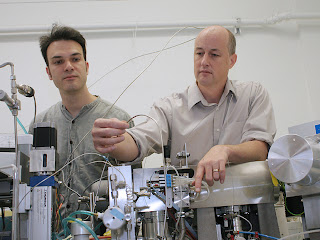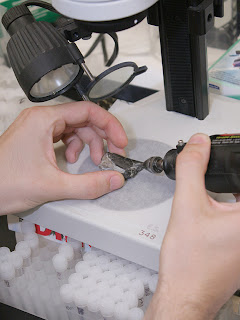I use Science Decoded for class and have assignments that require me to post in certain ways. This week I’m ATTEMPTING to write in a diamond structure (writers will know it but that means really specific- big issue- really specific.) I’m going to try to do so by tackling Amelia Earhart and the role of DNA analysis in identifying her possible remains, a subject I previously mentioned in the post What Happened to Amelia Earhart?
Today she is the topic of book reports, the namesake of streets, schools and scholarships, and even the subject of a major motion picture starring actress Hilary Swank. But in 1937 when she decided to fly around the world, Amelia Earhart – famous though she was – was also something unheard of at the time. She was a woman shattering convention – simply because she wanted to.
Amelia Earhart broke her first world record at the age of 24 on October 22, 1922 when she flew her airplane to an altitude of 14,000ft. The highest altitude then recorded for a female pilot. By April 8, 1931 she would beat her own record soaring to 18,415ft. She set four records for speed from 1930-1933, and in 1932 she was the first woman to fly solo across the Atlantic Ocean, five years to the day after Charles Lindberg first accomplished the feat. She wrote a book about the trip called “For the Fun of It.”
Earhart became a champion for women’s rights by being an outspoken female figure in a male dominated field. In 1932 she helped form, and was elected president of the Ninety Nines a club for women aviators.
According to the website operated by the estate of the famous aviator, Amelia Earhart is quoted as having said, “One of my favorite phobias is that girls, especially those whose tastes aren’t routine, often don’t get a fair break. It has come down through the generations, an inheritance of age-old customs which produced the corollary that women are bred to timidity.”
 |
| Source: Wikimedia Commons |
Earhart was the first person to fly solo from Los Angeles to Mexico City, the first person to fly from Mexico City to Newark nonstop, and the first person to fly across the Red Sea to India. Not just the first woman. She was the first PERSON to complete these milestone trips.
Having accomplished all of this it is no surprise that on June 1, 1937 when she was 39-years-old Earhart set out to become the first woman to fly around the world. She almost succeeded. On June 29th, Earhart and navigator Fred Noonan arrived in Lae, New Guinea with only 7,000 miles of the trip left. On July 2nd Earhart and Noonan took off for their next checkpoint at Howland Island.
It is here that the story of a strong female aviator, a role model for men and women alike becomes a mystery. She was sucked into the vortex of the Bermuda triangle. She flew to Rio to live a life of secrecy. She was abducted by aliens. Although the theories about why Earhart never arrived at Howland Island are many, truly no one knows what happened to her, Noonan, or their twin engine Lockheed Electra airplane. Although the most likely scenario is that Earhart and Noonan were unable to find Howland Island and then ran out of fuel.
With clouds obscuring the stars, Noonan’s ability to navigate would have been heavily compromised. The failure of their radio transmissions would have left Earhart and Noonan unable to ask for help. Landing in the ocean or on one of the South Pacific’s islands may or may not have killed the aviator. She was declared dead, but some say she could have survived the landing and lived for awhile as a castaway. This theory was buoyed in 2010 by the discovery of three bone fragments that might be a human finger on Nikumaroro (formerly known as Gardner Island) in the Republic of Kiribati.
It was on Nikumaroro in 1940 that a British Naval officer found 13 bones including a skull believed to belong to a castaway. The bones were sent to Fiji for analysis where they were later misplaced. A connection was never made to Earhart because at the time the bones were analyzed and believed to belong to a man. American officials were never officially notified of the discovery.
The International Group for Historic Aircraft Recovery (TIGHAR) took up the mystery of what happened to Earhart and Noonan and the possibility that the 1940 Nikumaroro bones were either the aviator or her navigator in 1988. An analysis of records from Fiji conducted by TIGHAR forensic anthropologists based on new computerized technology indicate that the initial analysis was wrong and the remains belonged to a white female.
TIGHAR conducted new searches of the island in 2001, 2007 and 2010. The search in 2010 turned up the three bone fragments, reportedly in the same area that the original 13 misplaced bones were found. TIGHAR recruited the help of Cecil Lewis of the University of Oklahoma’s Molecular Anthropology Laboratories to analyze the bone fragments. Last week TIGHAR announced that Lewis’ findings were inconclusive. It is possible that the bones are a human finger bone, but bones could also belong to a sea turtle. Other organisms like birds and fish have been ruled out due to the structure of the bone.
 |
| Nikumaroro Map. Source: Flickr. |
The initial test for the presence of human mitochondrial DNA conducted by Lewis was positive, but subsequent tests did not replicate that result. Because the process of extracting DNA damages the bone, further attempts to determine the bone’s origin would use up the rest of the sample. Doing so would make independent replication – a crucial part of the scientific process in which other scientists conduct the same experiment to make sure that the results are valid – an impossibility.
A mitochondrial DNA profile on Earhart has been compiled from a female relative. Mitochondria are an organelle – a small part of a cell. Mitochondria are involved in creating energy to power the cell. Unlike the rest of the cell, mitochondria contain DNA that is directly passed between mother and child, meaning that it is the same for all individuals on the maternal side of the family lineage.
TIGHAR has decided to shelve the DNA testing of the 2010 Nikumaroro bone fragments to ensure that in the future when DNA analysis technology improves to the point where less material is needed to discover if the bones are human (and if they are Earhart’s) there will still be enough of the bones left to test. But, when the bone is able to be tested for human DNA, the mitochondrial DNA profile of Earhart will be used to confirm if the bones are hers.
Other artifacts recovered from the Nikumaroro site (including what may be fecal matter, a freckle cream jar, and evidence of meals being cooked) are still being analyzed for direct evidence of Earhart or Noonan. Another expedition to Nikumaroro is scheduled for the summer of 2012 – to mark the 75th anniversary of Earhart’s flight and disappearance. The new expedition will focus on finding the remains of her Lockheed Electra, believed to be deep down on the slope of the reef on the Island’s west end.
The identification of Earhart’s remains (if they are hers) would be a triumph of scientific technology. As her story becomes intertwined with science, it becomes ever more ironic that Earhart didn’t view the information gathered from her flights as science. “I lay no claim to advancing scientific data other than advancing flying knowledge,” she said. “I can only say that I do it because I want to.”
If Earhart has a scientific legacy it is not to be found in her bones. Earhart believed women should never stop trying to excel in fields dominated by men. She busted the boys club of aviation, and paved the way for women to do the same in other fields. Female scientists who have broken into their own boys club, and penetrated the historically male dominated research fields embody Earhart’s determination to succeed.
Whether or not science will one day be able to tell if Earhart met her end on Nikumaroro Island, her legacy to science, and all of society, is in encouraging women to break with convention.
“Now and then women should do for themselves what men have already done – occasionally what men have not done – thereby establishing themselves as persons, and perhaps encouraging other women toward greater independence of through and action. Some such consideration was a contributing reason for my wanting to do what I so much wanted to do.”






